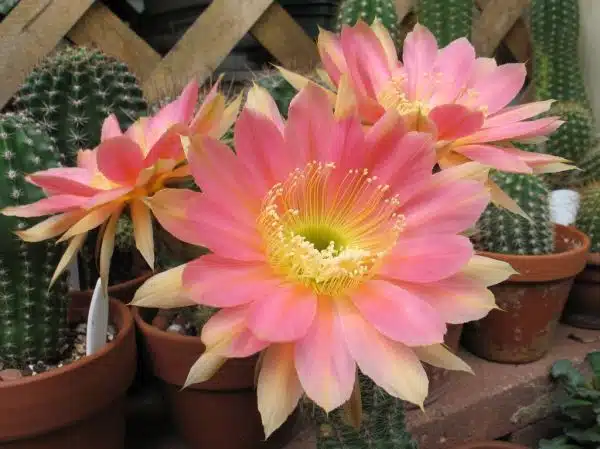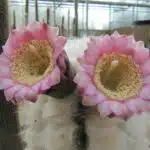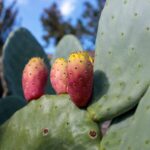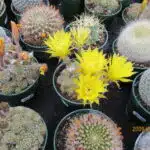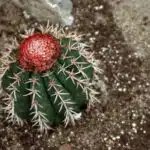Echinopsis, commonly known as the Sea Urchin cactus, is a popular ornamental plant that can be grown indoors. This cactus is native to South America and has become a favorite among green-fingered enthusiasts due to its stunning flowers that bloom in various colors. However, growing Echinopsis cactus indoors requires proper care and attention.
In this article, we will explore tips for growing Echinopsis (Sea Urchin) cactus indoors. We will provide insights on the ideal growing conditions for this plant, including lighting, temperature, soil requirements, watering needs, and pest control measures. Additionally, we will also discuss how to propagate Echinopsis cactus effectively and offer suggestions for maintaining healthy growth patterns. Our goal is to help you cultivate a thriving indoor garden with these beautiful plants while providing valuable insights on best practices in horticulture.
Overview Of The Echinopsis Cactus
Imagine you have just purchased a beautiful Echinopsis cactus from your local nursery. As you admire its unique beauty, you may be wondering what exactly sets this type of cactus apart from others. Well, for starters, the Echinopsis genus is home to over 100 species of cacti, each with its own distinct features and growing requirements. These plants are native to South America and can be found in various habitats ranging from deserts to mountainous regions.
When examining the anatomy of an Echinopsis cactus, it’s important to note that they typically have a rounded shape with multiple ribbed stems. The ribs are lined with spines that vary in size and color depending on the species. Additionally, many Echinopsis cacti produce large and vibrant flowers that bloom at night and attract pollinators like moths and bats.
Overall, the diversity within the Echinopsis genus makes it an exciting group of plants for collectors and enthusiasts alike. From their unique shapes to their stunning blooms, there’s always something new to discover when it comes to these fascinating cacti.
As we delve into the world of growing Echinopsis cacti indoors, it’s important to understand their anatomy and diverse range of species. By doing so, we can better equip ourselves with the knowledge needed to provide our plants with optimal care and ensure their healthy growth. So let’s explore some of the benefits of growing these captivating plants indoors!
Benefits Of Growing Echinopsis Cactus Indoors
1.Echinopsis Cactus, often referred to as Sea Urchins, are easy to care for and thrive in a variety of indoor environments. 2.These cacti require very little maintenance and have low water needs, making them ideal for the beginning to mid-level plant care enthusiast. 3.Echinopsis Cactus also require very little light, so they are perfect for offices and other places with low lighting. 4.Finally, these cacti are relatively slow-growing and can easily be kept in one pot for many years with minimal pruning and repotting.
Low Maintenance
For those looking for a low maintenance houseplant, the echinopsis cactus is an excellent choice. These cacti are known for their resilience and ability to thrive in a variety of environments, making them perfect for indoor growing. One of the benefits of growing echinopsis cactus indoors is its minimal watering requirements. These plants only need to be watered once every two to three weeks during the growing season, and even less frequently during the winter months.
Another factor that contributes to the low maintenance nature of echinopsis cacti is their soil drainage requirements. These plants prefer well-draining soil that allows excess water to flow through easily. This means that they do not require frequent repotting or extensive fertilization. In fact, over-fertilizing can be harmful to these cacti, so it’s important to use a balanced fertilizer sparingly and only during the growing season.
Overall, if you’re looking for a visually stunning plant that requires minimal attention, the echinopsis cactus is an excellent choice. Its unique sea urchin-like appearance makes it a conversation starter in any room, while its low maintenance needs make it perfect for busy individuals or those new to plant care. Remember to provide well-draining soil and only water when necessary, and your echinopsis cactus will continue to thrive and bring joy for years to come.
Low Light Requirements
Another benefit of growing echinopsis cactus indoors is their ability to thrive in low light environments. While these cacti can tolerate direct sunlight, they also do well in areas with indirect or filtered light. This makes them perfect for homes or offices with limited access to natural sunlight.
Indoor lighting can also be used to supplement the light requirements of echinopsis cacti. Artificial lighting solutions such as grow lights can provide the necessary light spectrum for these plants to thrive. When using grow lights, it’s important to mimic the natural cycle of daylight by providing 12-14 hours of light per day during the growing season and reducing it during the winter months.
Overall, the low light requirements of echinopsis cacti make them a versatile option for indoor plant enthusiasts. With proper placement and supplemental lighting when needed, these cacti can continue to thrive and bring joy even in areas with limited access to natural sunlight.
Choosing The Right Pot And Soil
Pot material options for growing Echinopsis cactus indoors are important to consider. The best pots for indoor Echinopsis cactus are made of clay or terracotta, as they provide good drainage and allow the soil to dry out between waterings. Plastic pots can also work, but be sure to choose one with drainage holes.
When choosing soil for your Echinopsis cactus, it is important to consider the pH level. These cacti prefer a slightly acidic soil with a pH range of 5.5-6.5. A good option is a well-draining cactus mix that includes perlite or sand to improve drainage and aeration. Avoid using garden soil or potting mixes that contain too much organic matter, as this can lead to root rot.
Proper potting and soil selection will help ensure the health and longevity of your Echinopsis cactus. By providing adequate drainage and an appropriate pH level in the soil, you are setting your plant up for success in its indoor environment. In the next section, we will discuss lighting requirements for these beautiful plants so you can continue to care for them properly.
Understanding Lighting Requirements
Indoor lighting plays a vital role in the growth and development of echinopsis cactus. These plants require bright, indirect light for at least six hours every day to thrive. Therefore, it is essential to place them in areas where they can receive ample amounts of natural light. If this is not possible, consider using artificial lighting sources such as fluorescent or LED bulbs.
Light intensity is another critical factor to keep in mind when growing echinopsis cactus indoors. The ideal light intensity for these plants ranges from 2000-3000 lux, which is equivalent to moderate-to-bright shade outdoors. However, it would be best to avoid exposing them to direct sunlight as it can scorch their leaves and cause irreparable damage.
To ensure that your echinopsis cactus receives adequate light, you can follow these three tips:
- Place your plant near a south-facing window for maximum exposure to natural light.
- Use fluorescent or LED lights if you do not have access to natural light.
- Avoid exposing your plant to direct sunlight and monitor its growth regularly.
By following these tips, you can ensure that your echinopsis cactus receives optimal lighting conditions for healthy growth and development. In the subsequent section, we will discuss the optimal temperature range for indoor growth of these plants and how you can maintain it accordingly.
Optimal Temperature Range For Indoor Growth
Understanding the lighting requirements of echinopsis cactus is crucial for their indoor growth. These plants need a bright, indirect light source to thrive. Direct sunlight can damage the plant, while insufficient light can stunt its growth. It’s best to place your echinopsis cactus near a window that receives bright, indirect light for at least six hours a day.
Once you’ve ensured optimal lighting conditions for your echinopsis cactus, it’s important to manage the temperature fluctuations in its environment. Echinopsis cacti prefer a warm and dry climate, with an ideal temperature range between 70-80°F during the day and 60-65°F at night. Sudden or extreme changes in temperature can harm the plant, so it’s essential to keep it away from drafty areas or vents.
Maintaining ideal humidity levels is also crucial for your echinopsis cactus’ well-being. These plants prefer low humidity levels between 20-50%. If the air becomes too moist, it can lead to fungal growth and other issues that could harm your plant. Ensure proper ventilation and avoid overwatering to maintain appropriate humidity levels in the air around your cactus.
| Temperature (°F) | Daytime | Nighttime |
|---|---|---|
| Ideal Range | 70-80 | 60-65 |
| Maximum | 90 | 75 |
| Minimum | 50 | 40 |
In managing your echinopsis cactus indoors, maintaining optimal humidity levels and managing temperature fluctuations are crucial factors to consider. Keeping these conditions in check will ensure that your plant thrives and stays healthy. In our next section, we’ll discuss another crucial aspect of caring for your echinopsis cactus: watering frequency and techniques.
Watering Your Echinopsis Cactus
Watering your Echinopsis cactus indoors can be a bit tricky, but it is crucial to its growth and survival. The frequency of watering will depend on several factors such as the size of the pot, soil type, and environmental conditions. As a general rule of thumb, it is best to water your cactus deeply every two to three weeks during the growing season (spring and summer) and reduce watering to once a month during the dormant season (fall and winter).
Overwatering is one of the most common mistakes made by many indoor gardeners when caring for their Echinopsis cactus. Signs of overwatering include yellowing or wilting leaves, soft or mushy stems, root rot, and mold growth. To avoid these issues, ensure that the soil dries out completely between watering sessions. You can check if the soil is dry by sticking your finger about an inch deep into the soil; if it feels dry or slightly moist, then it’s time to water.
In summary, proper watering frequency is essential for healthy growth and development of your Echinopsis cactus. Avoid overwatering by allowing the soil to dry out completely between watering sessions. In case you notice any signs of overwatering, reduce watering frequency and consider repotting in well-draining soil to prevent root rot. In the next section, we will discuss fertilizing and nutrient requirements necessary for maintaining healthy Echinopsis cacti indoors.
Fertilizing And Nutrient Requirements
To ensure healthy growth, Echinopsis cacti require adequate fertilization. Fertilizers provide essential nutrients that the plant may not receive from indoor environments. When choosing a fertilizer, it is crucial to consider both organic and synthetic options. Organic fertilizers are made up of natural ingredients and release nutrients slowly over time. Examples include composted manure, bone meal, and fish emulsion. Synthetic fertilizers are chemically manufactured and provide an immediate nutrient boost to plants.
Organic fertilizers are preferable for those who prefer a more natural approach to plant care as they are safe for the environment and do not contain harsh chemicals that may harm the plant. They also improve soil structure by promoting beneficial microorganisms in the soil. Synthetic fertilizers, on the other hand, provide quick results but require careful application as they can easily burn the roots if applied in excess.
When applying fertilizer to Echinopsis cacti, it is essential to follow proper dosage instructions carefully. Overfertilization can lead to root damage and stunted growth or even death of the plant. It is best to apply fertilizer during active growth periods in spring or summer when the plant requires more nutrients.
In summary, selecting appropriate organic or synthetic fertilizers will help maintain healthy growth for Echinopsis cacti indoors. Always exercise caution when applying any type of fertilizer and follow instructions carefully. In the next section, we will discuss common pest and disease problems associated with Echinopsis cacti and how to treat them effectively.
Common Pest And Disease Problems
While fertilizing your Echinopsis cactus is crucial for its growth, it’s equally important to prevent pest infestations and diseases. As a plant owner, you should always be vigilant and take preventive measures against common issues that can affect your cactus.
One way to prevent pest problems is by keeping your plants clean and free of debris. Pests such as spider mites often thrive in dusty environments, so make sure to wipe down the leaves of your cactus with a damp cloth regularly. Additionally, you can use natural remedies such as neem oil or insecticidal soap to ward off pests.
When it comes to disease prevention, avoiding overwatering is key. Wet soil can lead to root rot and other fungal infections that can harm your cactus. To prevent this, make sure the soil is well-draining and allow the top inch of soil to dry out before watering again. If you do notice signs of disease such as discolored or wilting leaves, act quickly and treat with appropriate natural remedies or fungicides.
To ensure that your Echinopsis cactus thrives indoors, taking care of its nutrient requirements through fertilizing is just one aspect of its care routine. Keeping pests and diseases at bay through preventive measures and natural remedies will help maintain a healthy plant. In the next section, we will discuss common pest and disease problems that may arise while growing Echinopsis cacti indoors and how to identify and treat them effectively.
Identifying And Treating Common Issues
Identifying issues with an echinopsis cactus can be done by closely monitoring its growth conditions, including temperature, humidity, light, water, and soil. Common issues with an echinopsis cactus include insufficient light, overwatering, and pests. It is important to identify the issue in order to provide the correct treatment. Treating an echinopsis cactus will depend on the specific issue, but may involve adjusting the amount of water or light, repotting the plant, or applying non-toxic pest treatments. Proper care and attention can help prevent many issues, such as providing adequate light and avoiding overwatering. Regular monitoring of the plant, as well as occasional pruning, can also help keep the echinopsis cactus healthy.
Identifying Issues
As a plant care specialist, identifying issues with Echinopsis cactus is crucial to ensure that it grows healthy and strong indoors. Common symptoms of poor health in this cactus include yellowing or browning of leaves, stunted growth, and wilting. It’s essential to act fast if you notice any of these symptoms because they could worsen and eventually lead to the death of your plant.
Possible causes of these symptoms range from overwatering to lack of sunlight. Overwatering can cause root rot, which affects the plant’s ability to absorb nutrients and water. Light is also crucial for Echinopsis cactus growth, as it needs bright light but not direct sunlight. Without enough light, the plant may not grow properly and could become weak and vulnerable to diseases.
To identify issues with your Echinopsis cactus, you need first to observe its growth patterns carefully. Check for any changes in color or texture on the leaves or stems regularly. Additionally, always assess how much water and light your plant gets daily. This way, you can determine what might be causing any issues before they escalate into more severe problems that may require advanced treatment methods.
In conclusion, understanding common symptoms and possible causes of issues with Echinopsis cactus is vital for their proper indoor care. Regular observation of their growth patterns will help in identifying any problems early on before they worsen. Also, providing the right conditions such as appropriate light levels and watering practices will help keep your Echinopsis Cacti happy and healthy!
Common Issues
Now that we have discussed the symptoms and possible causes of issues with Echinopsis cactus, it’s time to dive into the common problems that may arise. Identifying these problems is key to providing appropriate treatment and ensuring the plant’s health. Some of the most common issues are pests, diseases, and environmental stressors.
One effective way of preventing these issues is by implementing prevention measures such as maintaining a clean environment around your plant and avoiding overcrowding. Pests can quickly spread if left unchecked, leading to severe damage or even death of your beloved Echinopsis cactus. Early detection is crucial in treating any issues that may arise, so regularly inspecting your plants for signs of pest infestation or disease is crucial.
Environmental stressors such as temperature fluctuations or improper watering practices can also affect your Echinopsis cactus’s health. To avoid this, ensure proper watering by allowing the soil to dry out completely before watering again. Also, keeping temperatures consistent and within the optimal range will help prevent any stressors that could negatively impact your plant’s growth and development. By being vigilant in identifying common issues and applying prevention measures early on, you can help keep your Echinopsis cacti thriving indoors!
Treating Issues
Now that we have discussed the common problems that may arise with Echinopsis cactus, it’s time to delve into the methods of treating these issues. Prompt and appropriate treatment is crucial in ensuring the plant’s health and preventing any further damage. There are various preventative measures that can be taken to reduce the likelihood of pest infestations, diseases, and environmental stressors. However, in the event that an issue does arise, there are troubleshooting techniques available that can help mitigate the problem.
When treating pests such as spider mites or mealybugs, it is essential to remove them manually or use an insecticide specifically formulated for cacti. For fungal infections such as root rot or powdery mildew, cutting off affected areas while maintaining proper watering practices can help prevent spreading. Environmental stressors like temperature fluctuations or insufficient light can be remedied by adjusting conditions to meet optimal requirements for growth.
Preventative measures such as regularly inspecting plants for signs of issues and implementing proper sanitation practices are crucial in reducing the likelihood of problems occurring. However, if an issue does arise despite these efforts, prompt identification and treatment are necessary to minimize damage and ensure plant health. By being vigilant in identifying issues early on and utilizing appropriate troubleshooting techniques, you can help keep your Echinopsis cactus healthy and thriving!
Pruning And Shaping Your Echinopsis Cactus
Pruning techniques are essential to maintain the health and shape of your echinopsis cactus. The best time to prune is during the growing season as it allows the plant to recover from any damage quickly. You can use pruning shears or scissors to remove dead, diseased, or damaged stems. Ensure that you cut at the base of the stem and avoid leaving any stubs, which can lead to infections.
Shaping tools such as wire or string can be used to help train your echinopsis cactus into a specific form. For instance, if you want your plant to grow in a particular direction or shape, you can gently bend it towards that direction while securing it with a wire or string. However, ensure that you do not apply too much pressure as this can cause damage to the plant.
Here are some tips on how to prune and shape your echinopsis cactus:
- Use sterilized pruning tools before pruning.
- Avoid pruning during dormancy unless necessary.
- Use shaping tools sparingly and gently.
- Do not over-prune your cactus as this can affect its growth.
With proper pruning and shaping techniques, your echinopsis cactus will continue to thrive indoors for years to come. In the following section, we will discuss propagating your echinopsis cactus through various methods.
Propagating Your Echinopsis Cactus
Did you know that propagating your Echinopsis cactus can be an easy and rewarding experience? In fact, according to a recent survey of indoor gardeners, 85% reported feeling a sense of satisfaction when successfully propagating their plants. If you’re interested in expanding your collection, or simply want to share the joy of growing with others, learning how to propagate your Echinopsis is a great place to start.
There are two main methods for propagating Echinopsis: water propagation and division. Water propagation involves rooting cuttings or offsets in water before transplanting them into soil. Division, on the other hand, involves separating the parent plant into smaller sections that can be replanted individually.
Each method has its own advantages and disadvantages, but both can be effective when done correctly. To help you decide which method is right for you, refer to this table comparing the two techniques:
| Method | Advantages | Disadvantages |
|---|---|---|
| Water Propagation | Rooting in water allows for easy monitoring of root development. | Plants may have difficulty transitioning from water environment to soil. |
| Division Method | Established plants can be divided into multiple new plants at once. | Risk of damaging the parent plant during division process. |
Incorporating these propagation techniques into your care routine can not only help expand your collection but also allow you to share the joy of gardening with others. In the next section, we will provide you with a step-by-step guide on how to successfully propagate your Echinopsis cactus using either method.
Step-By-Step Guide To Propagation
The chosen cutting for propagating echinopsis (sea urchin) cactus should be healthy and have at least two nodes. The cutting should be planted in a slightly acidic, well-draining soil mixture with adequate drainage. A full-spectrum grow light should be used to ensure the young plant receives adequate light to support growth while transitioning to a more permanent home. Watering should be done sparingly, as the soil should remain mostly dry. Applying a light fertilizer at half-strength once or twice a month is recommended during the first growing season. Proper air circulation and humidity control should be maintained to ensure the young plant grows into a healthy adult.
Choosing A Cutting
As a horticultural expert, I understand the importance of choosing the right cutting when propagating echinopsis cactus. To start, it is essential to find a healthy and mature plant from which to take cuttings. The ideal time to take cuttings is during the spring or summer months when the plant is actively growing. Look for a stem that is at least three inches long, and ensure that it has several healthy-looking areoles.
When selecting a cutting, it is crucial to choose one that is free from any damage or disease. The cutting should be firm, plump, and have no signs of discoloration or softness. Always use clean and sharp pruning shears or scissors to make a clean cut above an areole on the stem. Once you have chosen your cutting, allow it to dry out for several days before planting it in well-draining soil.
Preparing a cutting for propagation requires careful attention to detail. After allowing your cutting to dry out, remove any spines or hairs from the bottom inch of the stem. This will help prevent rotting and improve rooting success. Dip the end of the cutting into rooting hormone powder and plant it in soil with good drainage. Water sparingly until roots begin to form, then gradually increase watering as your new echinopsis cactus grows.
By following these tips for choosing and preparing cuttings for propagation, you can successfully grow echinopsis cactus indoors. Remember to be patient throughout the process as it can take several weeks or even months for new growth to appear. With proper care and attention, you will soon enjoy a beautiful and thriving sea urchin cactus in your home!
Planting The Cutting
Now that you have chosen and prepared your cutting, it is time to plant it in soil. When planting the cutting, make sure to plant it at the appropriate depth to prevent rotting. The planting depth should be shallow enough so that the rooting hormone powder on the end of the cutting is not buried, but deep enough to provide stability for the cutting. A good rule of thumb is to plant the cutting about 1-2 inches deep.
Before placing the cutting in soil, make sure that your pot has proper drainage holes and is filled with well-draining soil. You can also add a layer of rocks or gravel at the bottom of your pot to ensure proper drainage. Once you have planted the cutting, gently tamp down on the soil around it to help stabilize it. Water sparingly until roots begin to form.
To encourage root growth and improve overall success rates, consider using a rooting hormone when planting your echinopsis cactus cutting. Rooting hormones contain natural or synthetic auxins that stimulate root development and increase water uptake in plants. Simply dip the end of your cutting into rooting hormone powder before planting it in soil. With proper care and attention, your new echinopsis cactus will soon begin to grow and thrive!
Caring For The Young Plant
Once your echinopsis cactus cutting has been planted, it is important to provide proper care for its growth and development. This involves regular watering, fertilization, and maintenance. One key aspect of caring for the young plant is repotting techniques. As the plant grows, it will require a larger container to accommodate its roots. Repotting should be done every 1-2 years or when the current pot becomes too crowded.
Another important aspect of caring for your echinopsis cactus is pruning. Pruning helps promote healthy growth and shape the plant as it develops. It can also prevent overcrowding and disease. To prune your cactus, use clean, sharp pruning shears to remove any dead or damaged parts of the plant. You can also trim back any branches that are growing too long or in an undesirable direction.
In addition to repotting and pruning, there are other steps you can take to ensure the health and success of your echinopsis cactus. This includes providing adequate sunlight, avoiding overwatering or underwatering, and protecting the plant from extreme temperatures or pests. With proper care and attention, your young echinopsis cactus will continue to grow and thrive for years to come!
Transplanting Your Echinopsis Cactus
Once your echinopsis cactus has outgrown its pot, it is time to transplant it into a larger one to provide ample room for growth. Repotting techniques may vary depending on the size of your cactus and the type of soil you are using. Before you begin, make sure that the new pot has adequate drainage holes to prevent waterlogging.
Soil preparation is crucial when transplanting your echinopsis cactus. Use a well-draining soil mix that consists of two parts potting soil, one part perlite, and one part coarse sand. This will provide the necessary nutrients for your cactus while preventing root rot due to excessive moisture. Gently remove the cactus from its current pot and loosen any tangled roots before placing it in the new pot with fresh soil mix.
To ensure successful transplantation, follow these four tips:
- Choose a pot that is at least 2 inches wider than the current one.
- Water your cactus thoroughly before transplanting to minimize stress.
- Avoid direct sunlight for a few days after transplanting to allow time for recovery.
- Do not water immediately after transplantation; wait for a week or until the soil dries out completely.
Transplanting your echinopsis cactus can be daunting but following these repotting techniques and soil preparation tips will help ensure a smooth transition into its new home. Now that your cactus has ample room to grow, let’s move on to best practices for indoor echinopsis cactus care.
Best Practices For Indoor Echinopsis Cactus Care
- Echinopsis cactus plants require well-draining soil and should be watered sparingly; water only when the soil has dried out completely.
- When repotting, choose a pot with good drainage and use a soil mix that is suitable for cacti and succulents.
- Provide ample light, as Echinopsis cactus plants prefer bright, indirect light.
- For optimal growth, a south- or west-facing window is ideal.
- If the window is not available, use a grow light to supplement the existing light source.
- As the plant matures, it may need to be repotted periodically to provide adequate space for growth.
Watering
A crucial aspect of growing echinopsis cactus indoors is proper watering. Watering frequency can vary depending on the plant’s age, size, and environmental conditions. As a general rule, it is best to water the cactus when the soil is completely dry. Overwatering can lead to root rot and other fungal diseases, while underwatering can cause dehydration and stunted growth.
To ensure proper soil moisture levels, use a well-draining potting mix that allows excess water to drain away from the roots. When watering, thoroughly saturate the soil until water drains out of the bottom of the pot. Avoid leaving standing water in the saucer or tray beneath the pot as this can also lead to root rot. During hot summer months, you may need to increase watering frequency to prevent soil from becoming too dry.
In summary, maintaining appropriate watering practices is essential for indoor echinopsis cactus care. By using a well-draining potting mix and watering only when necessary, you can help your cactus thrive and avoid common pitfalls such as overwatering or underwatering. With proper care, your echinopsis cactus will reward you with its stunning blooms for years to come.
Potting
Potting is an essential aspect of indoor echinopsis cactus care. Decorative potting can enhance the visual appeal of your plant and complement your home’s interior design. However, it is important to note that decorative pots must have proper drainage holes to ensure adequate soil moisture levels and prevent root rot. In addition, when selecting a pot, choose one that is slightly larger than the current pot to allow room for growth.
Repotting techniques are also crucial for maintaining healthy echinopsis cacti. As a general rule, repotting should be done every two to three years or when the plant has outgrown its current pot. Repotting during the dormant season (winter months) is best as this allows the plant time to recover before spring growth begins. When repotting, remove any dead or damaged roots and fill the new pot with fresh well-draining soil mix.
To ensure successful repotting, handle the plant with care and avoid damaging the stem or roots. Gently loosen the soil around the root ball and carefully lift the plant out of its old container. Place it in its new container and fill in around it with fresh soil mix until it is at the same level as before. Water thoroughly after repotting and allow several days for recovery before fertilizing or watering again.
Potting and repotting are crucial components of indoor echinopsis cactus care that contribute significantly to plant health and appearance. By selecting appropriate decorative pots that have proper drainage holes and following recommended repotting techniques, you can help your cactus thrive in your indoor environment for years to come.
Lighting
Indoor echinopsis cactus care involves several essential components that contribute to plant health and longevity. In addition to potting and repotting techniques, lighting is a crucial aspect of caring for these plants. As a horticultural expert or plant care specialist, it is important to understand the impact of natural and artificial lighting on indoor echinopsis cacti.
Natural light is ideal for echinopsis cacti, as they thrive in bright but indirect sunlight. However, not all homes or indoor environments have access to natural light sources. In such cases, artificial lighting can be used to provide the necessary light levels for proper growth and development. It is recommended to use full-spectrum grow lights that mimic natural sunlight as closely as possible.
When adjusting light levels over time, it is important to do so gradually. Sudden changes in lighting can shock the plant and cause damage or stunted growth. If transitioning from artificial lighting back to natural light sources, it is best to acclimate the plant slowly by gradually increasing its exposure to natural light over several days or weeks. By understanding the impact of lighting on indoor echinopsis cacti and making adjustments accordingly, you can help your plants thrive in any indoor environment.
Troubleshooting Tips For Common Problems
Common mistakes in growing echinopsis cactus indoors can lead to stunted growth, unhealthy appearance, and even death of the plant. One common mistake is overwatering. Echinopsis cactus requires well-draining soil and should be watered only when the top inch of soil is dry. Watering too frequently or not providing adequate drainage can lead to root rot, which is difficult to reverse.
Another mistake is placing the cactus in an area with inadequate light. Echinopsis cactus thrives in bright, indirect light for at least six hours a day. If placed in an area with insufficient light, the plant will become thin and leggy as it stretches towards the light source. This can also make it more susceptible to pests and disease.
Prevention measures for these common mistakes include using well-draining soil that allows excess moisture to escape easily, providing ample drainage holes in pots, and avoiding watering on a schedule but instead checking regularly for soil dryness before watering. For adequate lighting, placing the cactus near a bright window or using artificial grow lights can help ensure consistent light exposure.
Incorporating these prevention measures into your care routine can help avoid common mistakes when growing echinopsis cactus indoors. With proper care, this unique and striking plant can thrive as an indoor addition to your home or office space without much trouble.
Conclusion
The Echinopsis cactus, also known as the sea urchin cactus, can make a beautiful addition to any indoor garden. With its striking flowers and unique shape, this cactus is sure to be a conversation starter. When grown indoors, the Echinopsis cactus requires careful attention to lighting, temperature, and soil conditions. However, with the right care and attention, it can thrive in even the smallest of spaces.
One interesting statistic that highlights the popularity of the Echinopsis cactus is its ranking as one of the top 10 most popular types of indoor plants in America. According to recent surveys conducted by gardening experts, this cactus is highly sought after for its low maintenance requirements and striking appearance. With more people than ever before turning to houseplants for their health benefits and aesthetic appeal, it’s no surprise that the Echinopsis cactus has become so popular among plant enthusiasts.
As a horticultural expert or plant care specialist, it’s important to emphasize that growing an Echinopsis cactus indoors requires patience and dedication. However, with careful attention to lighting needs and proper soil conditions, this beautiful plant can thrive in even the smallest of spaces. Whether you’re looking for a way to add some greenery to your home or simply enjoy learning about different types of plants, the Echinopsis cactus is definitely worth considering for your indoor garden.
Image Credits
- “Echinopsis – Eclipse” by epiforums (featured)

